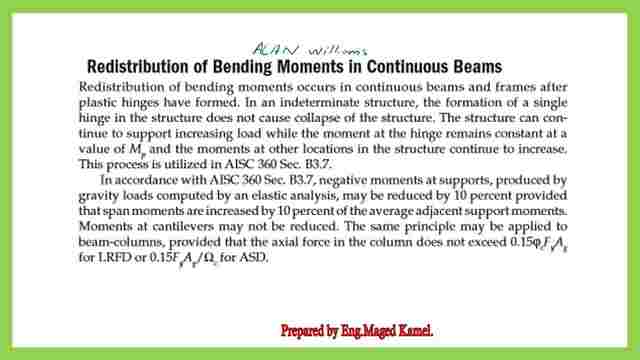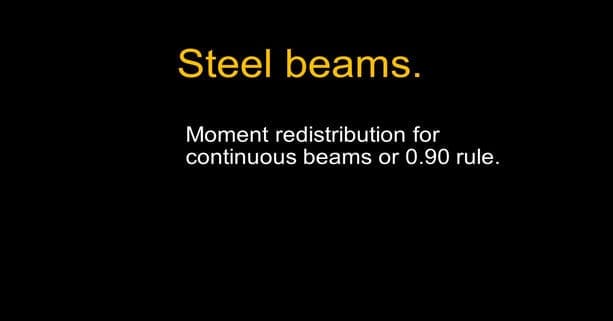Moment Redistribution For Continuous Steel Beams.
Elastic redistribution for Moment values.
A new subject is the design of continuous beams. the first method is by using the elastic method of moment redistribution.
let us have a look at the shapes W-shapes, M shapes, S-shapes, Hp-shapes and c-shapes, L-SHAPES, wt-shapes, HSS-shapes, and pipe-shapes, and the ASTM designation, the values of both Fy and Fult for each of these shapes.
This is a brief revision of the values of Fy and Fult for the different types of ASTM.
The next image shows the values of shear and moment for continuous beams with multiple spans.
We are aware of this method, the code permits utilizing this moment by making redistribution for the moment.
The AISC has issued table 3-23 in which, let us review the fixed end, the beam of span= L under uniformly distributed load, the fixed end moments will be w*L^2/12 from both ends, the reaction will be WL/2 at both ends, the shear magnitude for will be w*L/2 the values for the shear, positive, and negative moment values, for the different loading cases Condition.
For instance, simply supported beams, fixed at both ends, continuous beams supported on multiple spans and different loading conditions. For example, concentrated and uniformly distributed, the fixed end moments will be w*L^2/12 from both ends, as shown in the given sketches.
The reaction will be W*L/2 at both ends, the shear force diagram is also drawn.
The free-body diagram is created after removing the supports from the ends and replacing them with reaction forces and moments.
The bending moment diagram has a negative value at the ends, which are wL^2/12, as drawn at the tail of the moment arrow.
The positive value of the moment will be w*L^2/24 since we subtract w*L^2/12 from the W*L^2/8, this moment will be in the middle.
The main point will be how to make a redistribution of the bending moments of continuous steel beams and fixed-end beams.
I quote from both profs. Bowles and Alan Williams’s books, the principle of moment redistribution can be performed if the section of the beam is compact and is not a cantilever.


The principle of moment redistribution can be performed if the section of the beam is compact and is not a cantilever.


How to perform redistribution?
A section may be designed based on either using 0.90* largest negative moment or positive moment based on a maximum positive moment from the moment diagram + 10%* average negative span moments, whichever is larger.
When the beam or girder is rigidly framed into a column, the design moment value. The column at that point can also be reduced by 10%.
Elastic moment distribution for a continuous beam with two equal spans.
If we want to apply the 0.90 rule for the fixed-end moment beam. Apply the moment redistribution, then the net value of the fixed end moment will be Wl^2*0.1125.
The positive bending moment will be increased by the value of 0.5* 0.10*(w*L^2)*0.125=0.00625 WL^2.
Elastic moment distribution for Fixed end beam.
This sketch shows the values of shear and bending moment values for the fixed end beam before redistribution of the moment for the fixed end beam.
If we want to apply the 0.90 rule for moment redistribution. For the fixed-end moment beam, the net value of the fixed-end moment will be Wl^2/13.33.
The positive bending moment will be increased by the value of 0.10*(w*L^2)/12=0.0083333 WL^2. The value of the moment after using the 0.90 rule is shown in the slide image.
This is the pdf file used in the illustration of this post.
The next post is a Solved Problem 4-15. The post includes how to design a continuous beam of two spans.
For a useful link about the distribution of continuous beams.

